Introductory remarks: The Neogene Foramifera
The Oligocene–Miocene boundary was not such a significant event for larger benthic foraminifera as the sharply defined Cretaceous–Paleocene boundary. Nearly 80% of species survived the boundary into the Miocene and most of the Miocene superfamiles are extant, however, provincialism is prominent at both the generic and specific levels (BouDagher-Fadel, 2008). The main lines of evolution follow the same patterns as in the Oligocene, despite evolutionary lineages at the species level. While provincialism was not distinct during the Early Miocene, by the Middle Miocene, provincialism was established with the narrowing of the Tethys. For instance, deep-water textulariines made their first appearance in America, while new genera of alveolinids appeared in the Indo-Pacific. The development of the Indo-Pacific as a separate province continued in the Late Miocene and most superfamiles continued to survive with globally spread representatives (BouDagher-Fadel, 2008).
This page aims to summarize the taxonomy of the most significant large benthic foraminifera that appeared during the Neogene period (eg. Miocene, Pliocene epochs). The three major suborders that thrived during the Paleogene included
Miliolina,
Rotaliina, and Textulariina (see figure below).
Superfamilies, families and genera of these suborders will be discussed following the text of
Dr. Marcelle K. BouDagher-Fadel of the University College of London - MIRACLE. Chapter 7 of BouDagher-Fadel (2008) presents a comprehensive overview of the main genera of the Neogene larger foraminifera and prominent researchers, evolutionary lineages and phylogenetic relationships, biostratigraphic ages and paleoenvironmental interpretations.
The evolution of the Neogene suborders (thick lines and superfamilies (thin lines) of larger foraminifera
SUBORDER MILIOLINA
- Test: porcelaneous and imperforate made of high–magnesium calcite with fine randomly oriented crystals
- Geologic range: Carboniferous to Holocene
Superfamily ALVEOLINOIDEA
- Test: enrolled along an elongate axis, initially planispiral or streptospiral, or milioline with chambers added in varying planes
- Geologic range: Cretaceous to Holocene
Family Alveolinidae
- Test: free, fusiform, coiled along an elongate axis (see Paleogene sub-page for full description)
- Geologic range: Early Cretaceous to Holocene
- Genera: Alveolinella; Flosculinella
![]() 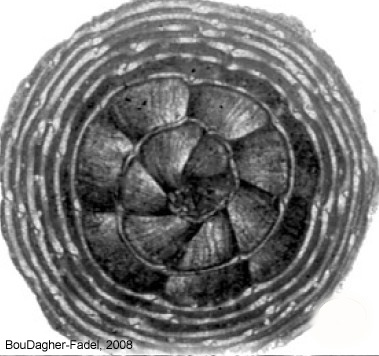 |
Test: elongate fusiform, with several rows of chamberlets in axial section. Pre-septal passages connect adjacent chamberlets, with smaller secondary pre-septal passages in later whorls. The final chamber has numerous rows of apertures.
Geologic range: Late Middle Miocene to Holocene
|
![]() 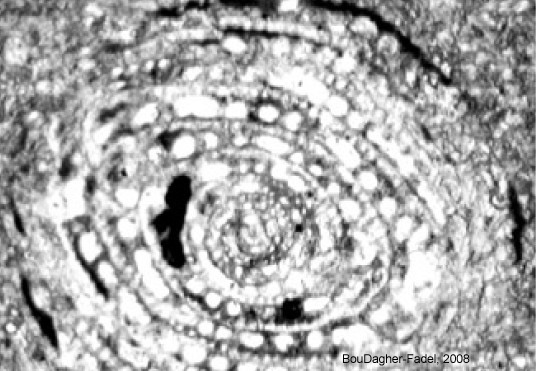 |
Test: early part is streptospiral but with double rows of chamberlets on the floor of each chamber, one row being smaller than the other
Geologic range: Late Early Miocene to Middle Miocene
|
Superfamily CORNUSPIROIDEA
- Test: free or attached composed of a globular proloculus, followed by a tubular enrolled chamber
- Coiling: planispiral or trochospiral, evolute or involute, and may become irregular
- Aperture: simple at the end of the tube
- Geologic range: Lower Carboniferous to Holocene
Family Discospirinidae
- Test: discoid with globular proloculus, followed by a planispirally enrolled test. The later chambers are annular and may be subdivided into small chamberlets.
- Geologic range: Middle Miocene to Holocene
- Genera: discospirina
![]() 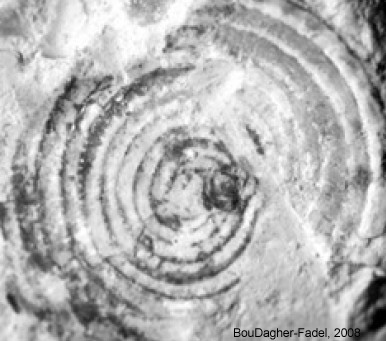 |
Test: large, fragile, thin and flattened, with a peneropliform early stage, followed by annular chambers subdivided by numerous internal septa that fall short of the anterior wall of each chamber
Geologic range: Middle Miocene to Holocene
|
Superfamily MILIOLOIDEA
- Test: soiled in varying planes or uncoiled, cylindrical or compressed with partial partitions
- Geologic range: Upper Triassic to Holocene
Family Rivieroinidae
- Test: planispiral, ovate in outline with chambers subdivided by oblique sutures
- Aperture: a single curved slit, but may be cribrate
- Geologic range: Middle Eocene to Holocene
- Genera: Riveroina; Pseudohauerinella
Superfamily SORITOIDEA
- Chambers: planispiral, uncoiling, flabelliform or cyclical, and may be subdivided by partitions or pillars
- Geologic range: Late Permian to Holocene
Family Peneroplidae
- Test: a closely coiled early stage becoming uncoiled in later stages
- Chamber: interiors are simple. Aperture: single rounded, slit-like or multiple
- Geologic range: Late Cretaceous to Holocene
- Genera: Laevipeneroplis
Family Soritidae
- Test: biconvex, involute-planispiral to uncoiled evolute, flaring, annular discoid with partial or complete partitions
- Aperture: multiple
- Geologic range: Late Cretaceous to Holocene
- Genera: Androsina; Androsinopsis; Annulosorites; Cycloputeolina; Fusarchaias; Marginopora; Miarchaias; Miosorites; Parasorites; Pseudotaberina
![]() 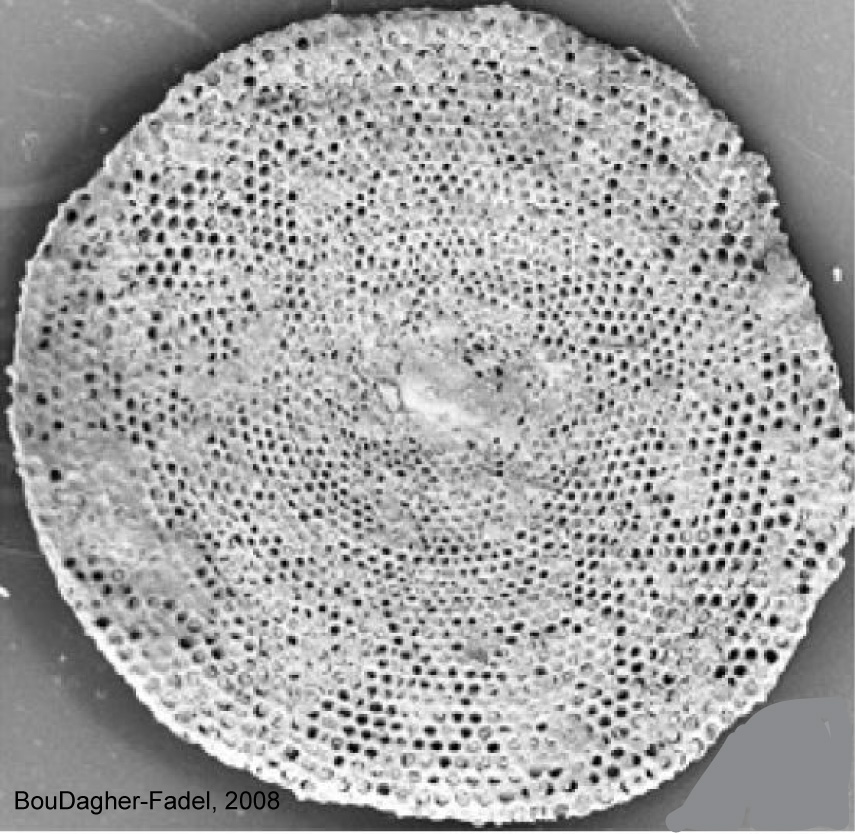 |
Test: large, biconcave. The microspheric test has an early planispiral and peneropline stage followed by annular, concentric chambers, with thickened and
folded margins. Initially with two layers of annular chamberlets, later low chambers are inserted between them. The annular chambers are subdivided by incomplete vertical septula and partitions.
Geologic range: Latest Middle Miocene to Holocene
|
![]() 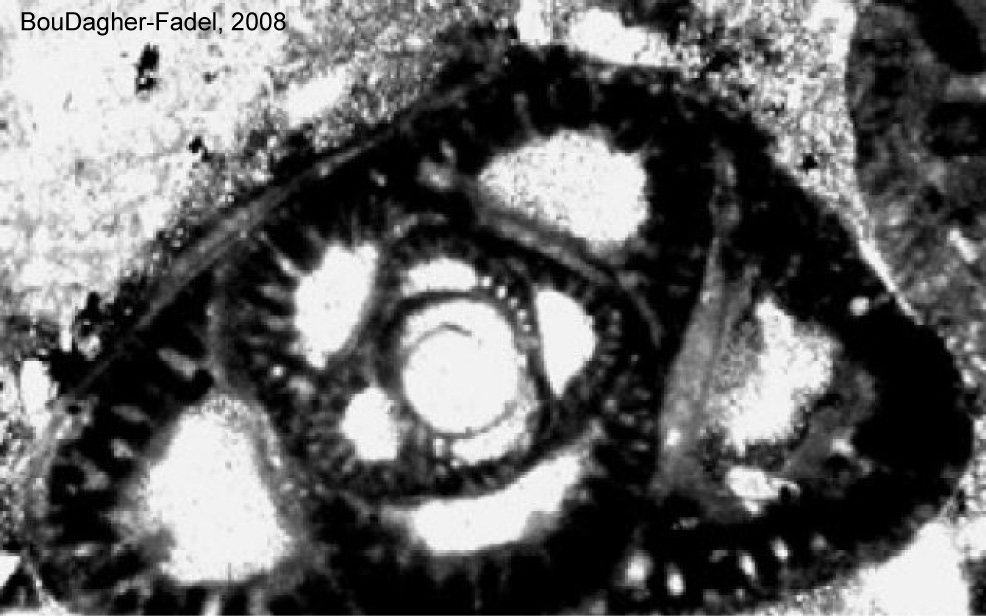 |
Test: becoming cyclical in the latest growth of the microspheric form. Megalospheric forms have a large proloculus. Later chambers are not embracing and may become cyclical and evolute. Chambers show ‘‘stalagmitic’’ and ‘‘stalactitic’’ projections/
pillars that discontinuously fuse across the chambers away from the lateral walls, producing chamber-subdividing structures.
Geologic range: Early Miocene
|
Family Keramosphaeridae
- Test: globular with concentric chambers connected by stolons in the same series as well as those of successive series
- Geologic range: Early Cretaceous to Late Cretaceous, and Miocene to Holocene
- Genera: Kanakaia; Keramosphaera
SUBORDER ROTALIINA
- Test: multilocular
- Wall: calcareous, made of perforate, hyaline lamellar calcite
- Aperture: simple or with an internal toothplate
- Geologic range: Triassic to Holocene
Superfamily ASTERIGERINOIDEA
- Test: trochospiral to planispiral, umbilicus closed. Chambers have internal partitions
- Aperture: umbilical, may extend up to the apertural face with complex chamberlets at the centre of the umbilical side
- Late Cretaceous to Holocene
Family Lepidocyclinidae
- Test: discoidal, involute, biconvex with a broad centrum, which grades into a narrow flange. Adauxiliary chambers may be present. A primary spire persisting into the equatorial layer, or with annular rings of chamberlets immediately following the embryont
- Geologic range: Middle Eocene to Middle Miocene
Subfamily Lepidocyclininae
- Test: bilocular or multilocular embryonal stage,
- surrounded by a thickened wall and adauxiliary chambers. Spirally arranged chambers do not completely surround the embryon. Post-embryonic chambers are cyclical, arcuate to hexagonal in shape, usually with two or more apertures.
- Geologic range: Middle Eocene to Middle Miocene
- Genera: Multilepidina
Superfamily NUMMULITOIDEA
- Test: planispiral or cyclic, lenticular, multicamerate, with septal flap and canaliculated septa. A spiral marginal cord and spiral canal system are present in early forms, and are modified in advanced forms or replaced by intraseptal canals.
- Geologic range: Paleocene to Holocene
Family Cycloclypeidae
- Test: concentric annular chambers, that are wholly evolute, with each chamber divided into numerous chamberlets in the median plane, and with each chamberlet separated from adjacent chamberlets by
- canaliculated, straight walls
- Geologic range: Eocene to Holocene
- Genera: Katacycloclypeus
![]() 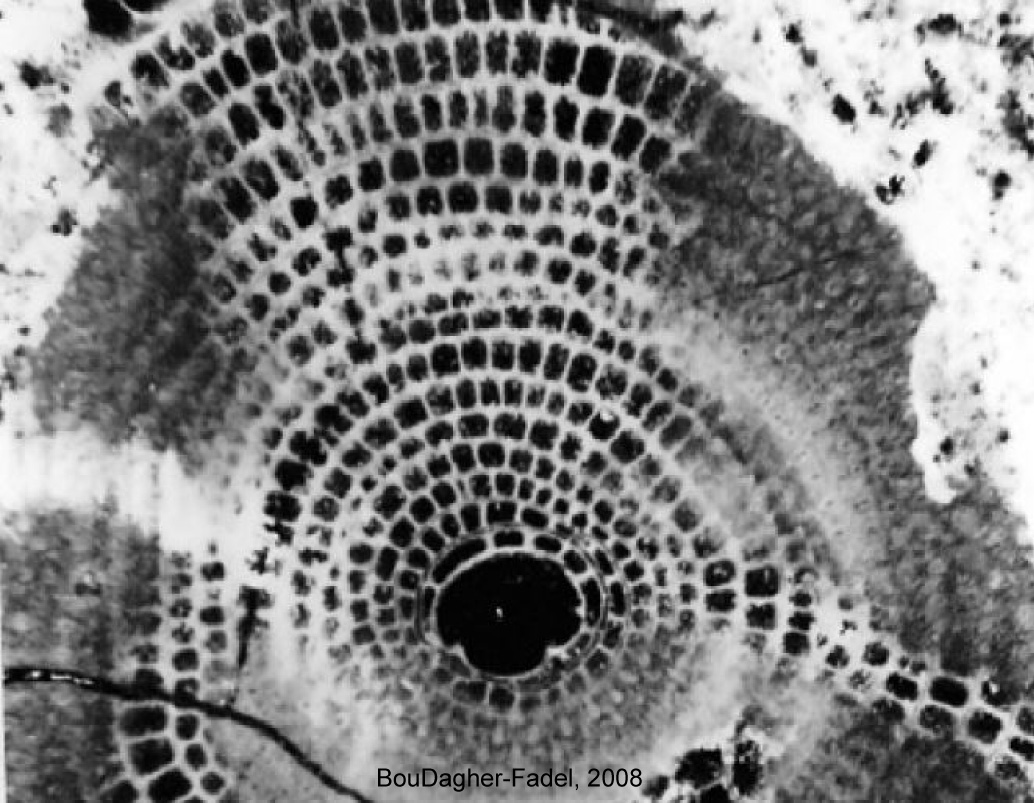 |
Test: Though classified as a new subgenus of Cycloclypeus, the two forms should be considered only generically different due to similar embryonic structure
Geologic range: Middle Miocene
|
Family Nummulitidae
- Test: planispiral, involute or evolute, with septal, marginal and vertical canals
- Geologic range: Paleocene to Holocene
- Genera: Geterocyclina; Bozorgniella; Planoperculina; Radiocycloclypeus
Superfamily PLANORBULINOIDEA
- Test: trochospiral in early stages, but later may be uncoiled and rectilinear, or biserial or may have many chambers in the whorl. Intra- to extra-umbilical apertures occur, and additional equatorial apertures may be present.
- Geologic range: Early Cretaceous to Holocene
Family Planorbulinidae
- Test: free or attached, early stage is trochospiral but later becoming discoid, sylindrical or conical.
- Aperture: single or multiple
- Geologic range: Eocene to Holocene
- Genera: Planorbulinopsis
Family Victroiellidae
- Test: attached or may be free in the juvenile stage with a trochospiral early stage, later becoming an irregular mass of chambers.
- Geologic range: Cretaceous to Holocene
Subfamily Rupertininae
- Test: attached with a distinct flattened disk, but coiling grows out away from the site of attachment. Late Geologic range: Cretaceous to Holocene
- Genera: Rupertina
![]() 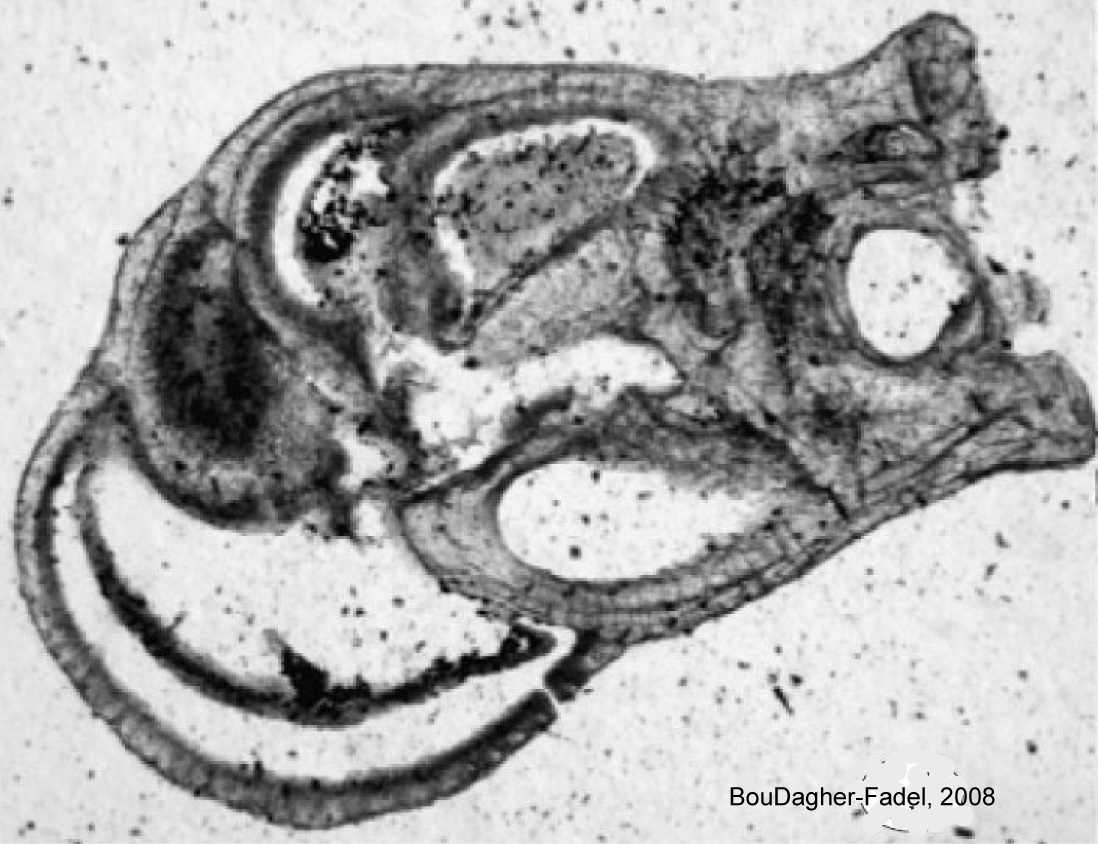 |
Test: growing upright around a central column. Trochospiral in the early stage, later more loosely coiled.
Geologic range:Miocene to Holocene
|
Superfamily ROTALOIDEA
- Test: involute to evolute, initially trochospiral or planispiral, commonly with many chambers in numerous whorls. As new chambers are added, septal flaps attach to previous apertural face and enclose radial canals, fissures, umbilical cavities, and intraseptal and subsutural canals.
- Wall: made of perforate hyaline calcite, that is generally optically radial in structure. Primary apertures are single or multiple. Small openings into the canal system may occur along the sutures.
- Geologic range: Late Cretaceous (Coniacian) to Holocene
Family Calcarinidae
- Test: enrolled with protruding canaliculated spines. Free living, but they live mostly adhered to algae by a kind of plate secreted at the end of one, or more rarely two, spines. Rows of areal foramina are found mostly near the base of the septa
- Geologic range: Late Cretaceous to Holocene
- Genera: Baculogypsina; Baculogypsinoides; Calcarina; Quasirotalia; Schlumbergerella
![]() 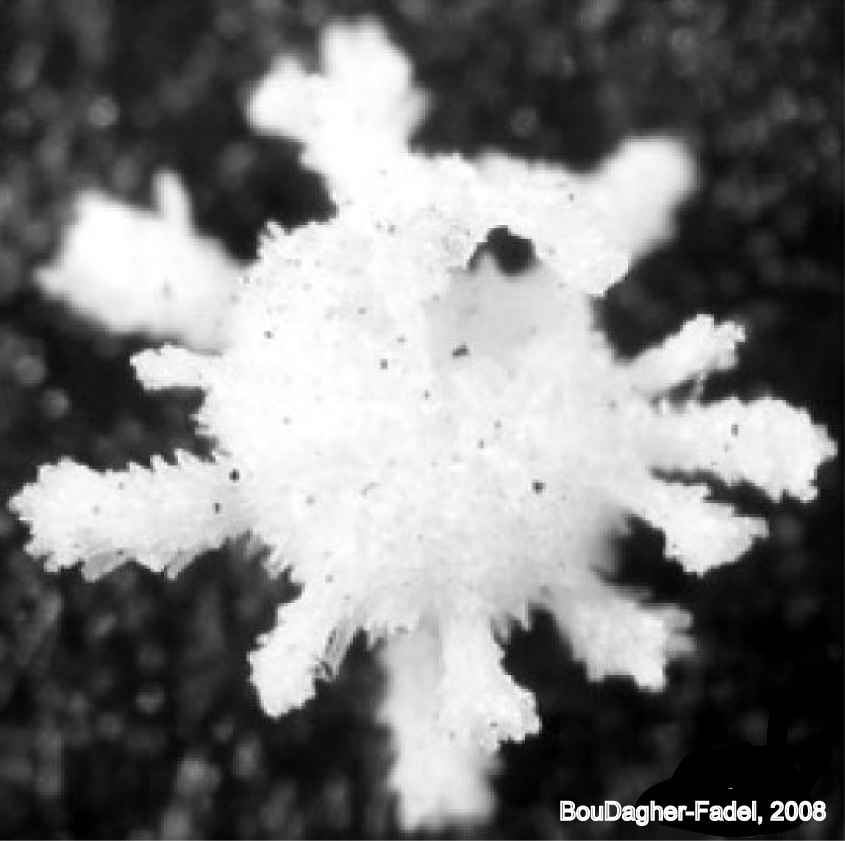 |
Test: biconvex, trochospirally coiled throughout, with
many blunt or bifurcating radial spines. There is an enveloping spiral canal system consisting of a layer formed by numerous canals that run through the spines.Pustules and spinules cover the whole test with the umbilicus filled by pillars.
Geologic range: Pliocene to Holocene
|
Family Chapmainidae
- Test: conical, with a trochospiral initial part, followed by a uniserial part and a tubular apertural systemChamber: may be annular in the adult part of the test
- Septa: invaginated into tube pillars
- Geologic range: Late Paleocene to Late Miocene
- Genera: Tenisonina
Family Miogypsinidae
- Test: flattened to biconvex. The microspheric form has a trochospiral or planispiral early spire, while the megalospheric form has a bilocular embryonal stage followed by a fan of median chamberlets
- Geologic range: Middle Oligocene to Middle Miocene
- Genera: Heterosteginoides; Lepidosemicyclina; Miogypsinodella; Miolepidocyclina; Tania
![]() 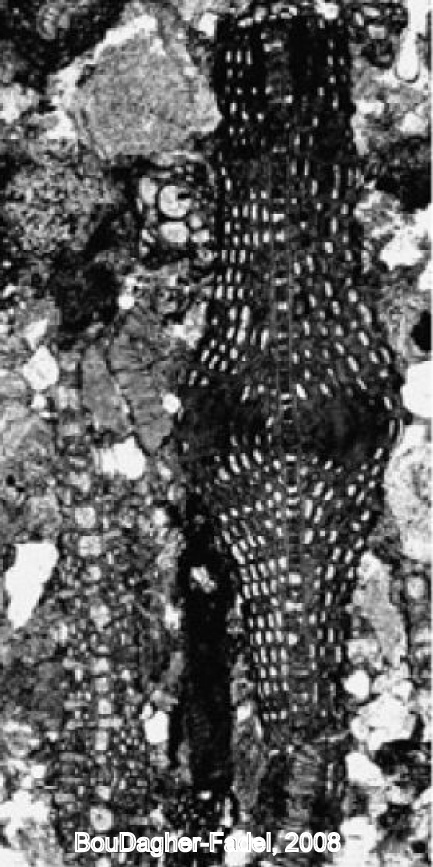 |
Test: A roughly circular test, with an embryonic
apparatus made of a spherical protoconch and a reniform deuteroconch, has a tendency to become enlarged in most advanced forms. Two sets of planispiral periembryonic chambers surround the embryo, the larger primary spiral and three unequal secondary spirals.
Geologic range: Early Miocene
|
![]() 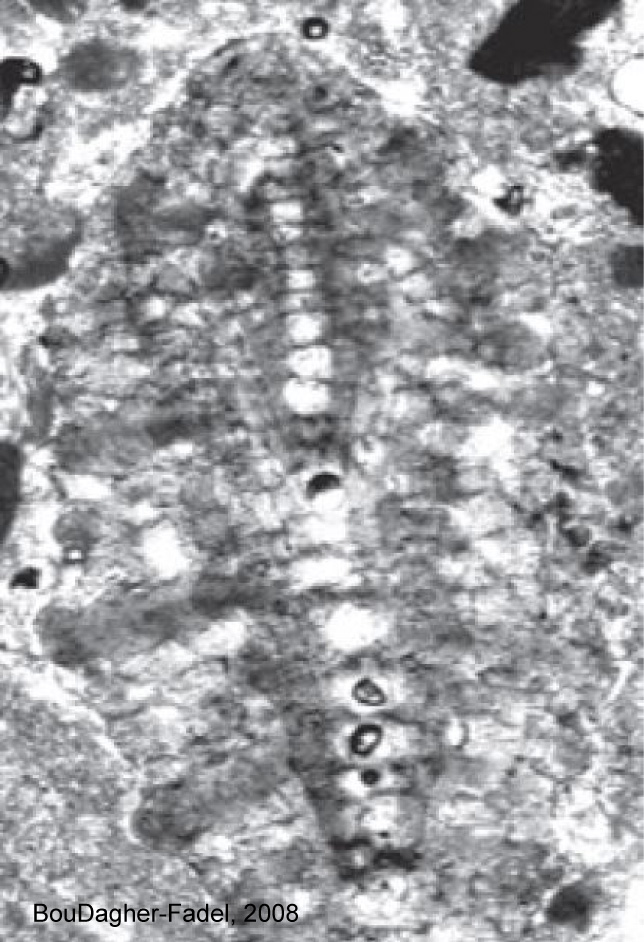 |
Test: The embryont coil is similar to that of Miogypsinoides, it is virtually planispiral, but there is only one whorl around the megalospheric proloculus, and a septal canal system is present. Also, the lateral walls have gaps between the lamellae, which begin to split apart and form the beginnings of lateral chamberlets
Geologic range: Early Miocene to Middle Miocene
|
![]() 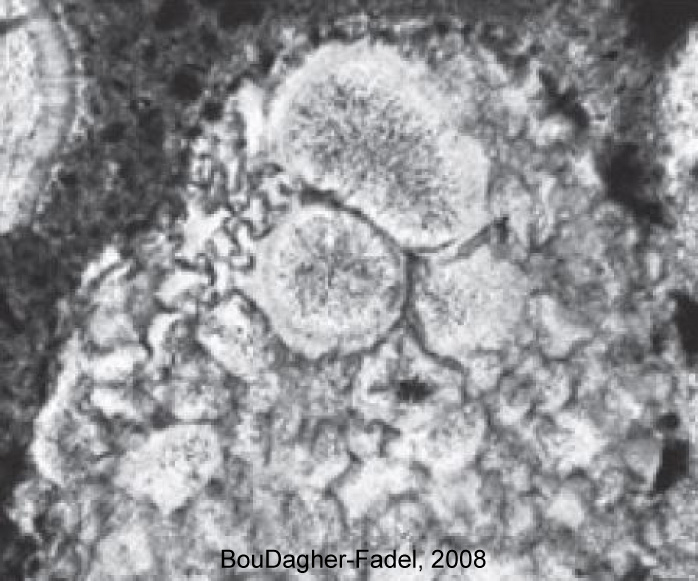 |
Test: The embryonic apparatus, consisting of large
protoconch and deuteroconch, is surrounded by a thick wall. The megalospheric nepiont is similar to that of Miogypsina, with no coil around the proloculus but
2-bidirectional coils around the proloculus. However, the nepiont is centrally placed, instead of being at the edge of the test, as in Miogypsina
Geologic range: Early Oligocene to Early Miocene
|
Superfamily ACERVULIOIDEA
- Test: trochospiral to discoidal, commonly with raspberry-like (or framboidal) early chambers, but with an encrusting later part consisting of numerous irregularly formed chambers
- Geologic range: Paleocene to Holocene
Family Acervulinidae
- Test: The early stage is followed by spreading chambers with one or more layers. Mural
- pores act as apertures.
- Geologic range: Paleocene to Holocene
- Genera: Acervulina; Alanlordia; Borodinia; Ladoronia; Planogypsina
![]()  |
Test: biconvex, proloculus followed by a single,
nearly planispiral whorl of triangular chambers each successively linked by a single basal, septal aperture, but in which multiple, cribrate, pore-like apertures develop in their distal, outermost walls. The initial whorl is succeeded both dorsally and ventrallyby layers of small chambers which are added in radial rows to form successive layers of small chambers
Geologic range: Middle Miocene to Late Pliocene
|
![]() 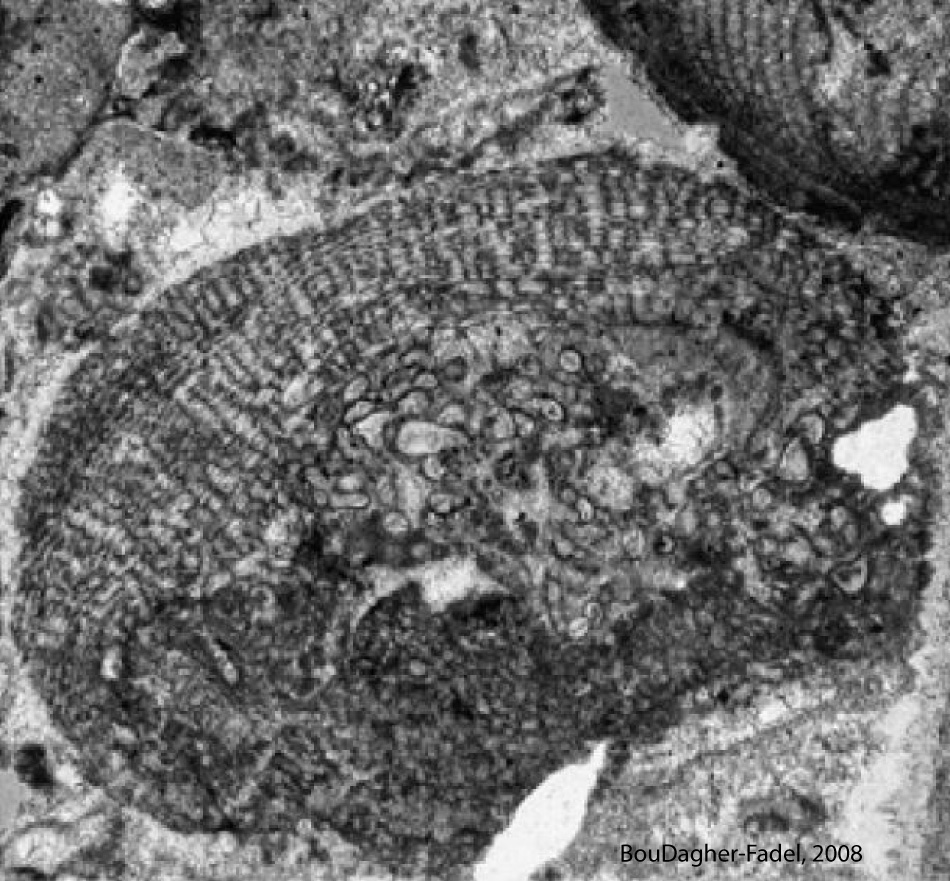 |
Test: has more than one encrusting layer, with chambers alternating in position in successive layers.
Geologic range: Early Miocene
|
Family Homotrematidae
- Test: attached, with a trochospiral early stage, later chambers growing in a massive branching structure
- Geologic range: Eocene to Holocene
- Genera: Homotrema; Miniacina
![]() 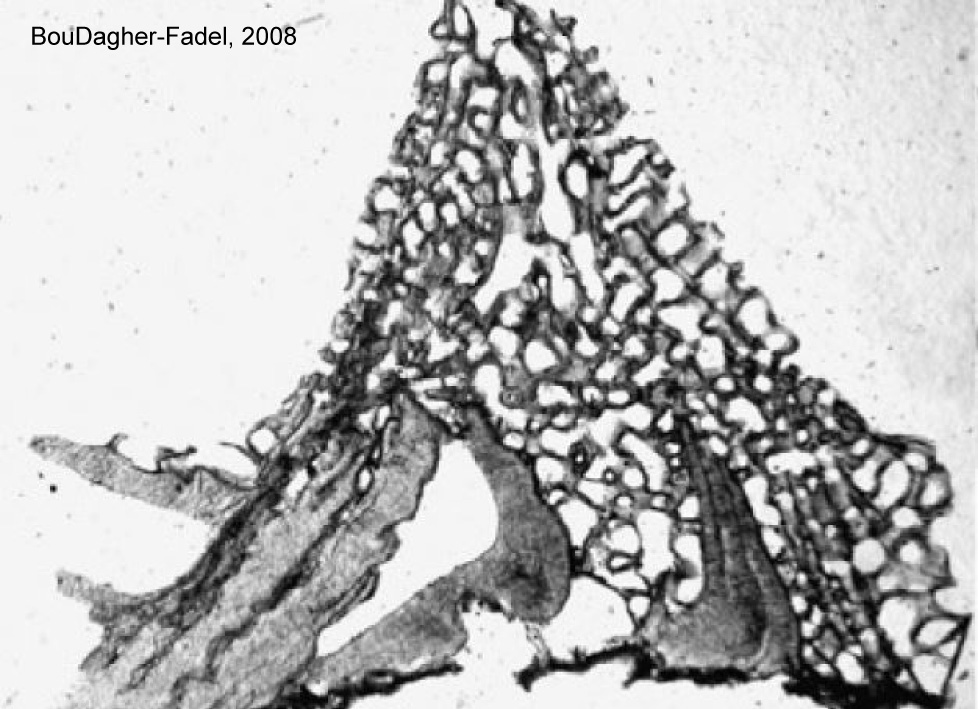 |
Test: A homotremid form, with a four-chambered embryo and conical projections or erect branches. Early chambers occur in clustered arrangement, but later in numerous layers with large irregular passages.
Aperture: made up of larger perforations
Geologic range:Miocene to Holocene
|
![]() 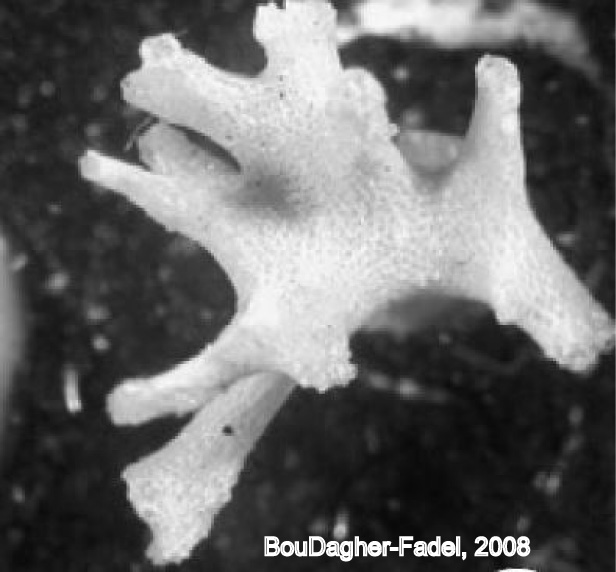 |
Test: Megalospheric forms have a three-chambered juvenile, while microspheric forms have a trochospiral early stage. Following the free early stage, the attachment surface is narrow, and from this surface arise vertical irregularly branching structures with pillar-pore chambers (calyces) surrounding the central core.
Geologic range:Early Miocene to Holocene
|
SUBORDER TEXTULARIINA
- Test: made of foreign particles bound by organic cement
- Geologic range: Lower Cambrian to Holocene
Family Alveovalvulinidae
- Test: trochospiral to triserial and uniserial. Chambers have alveoli conjoined with vertical radial partitions or ‘‘tubiliform connections’’
- Aperture: interiomarginal or terminal
- Genera: Alveovalvulina; Guppyella; Jarvisella
Family Textulariellidae
- Test: an early trochospirally enrolled stage, which later is reduced to triserial or uniserial
- Chamber: overlapping
- Wall: agglutinated with alveoles
- Geologic range: Miocene
- Genera: Cuneolinella; Textulariella
Superfamily PAVONITINOIDEA
- Test: early stage is coiled, triserial to biserial or uniserial. The interiors of the chambers are partially divided by numerous vertical partitions (beams) or septula, that project downwards from the roof and rarely may have a few connecting horizontal partitions (rafters)
- Geologic range: Late Cretaceous and Oligocene to Pliocene
Family Pavonitinidae
- Test: palmate, triangular in section
- Aperture: terminal single or multiple
- Geologic range: Oligocene to Pliocene
Subfamily Pavonitininae
- Test: triserial, biserial or uniserial.
- Chambers: undivided by secondary septula
- Geologic range: Oligocene to Miocene
- Genera: Pseudotriplasia
Superfamily TEXTULARIOIDEA
- Test: trochospiral, biserial or triserial in early stages, but later may be uniserial or biserial
- Wall: agglutinated, canaliculated
- Geologic range: Early Jurassic (Sinemurian) to Holocene
Family Textulariidae
- Test: early stage is biserial, but may be reduced to uniserial
- Aperture: single or multiple
- Geologic range: Paleocene to Holocene
Subfamily Tawitawinnae
- Test: biserial throughout, compressed and palmate
- Chambers: subdivided by short septula.
- Wall: thin, canaliculate
- Aperture: multiple
- Geologic range: Holocene
- Genera: Tawitawia
References
BouDagher-Fadel, M.K., 2008. Evolution and Geological Significance of Larger Benthic Foraminifera. Developments in Paleontology and stratigraphy, v. 21, 540p.